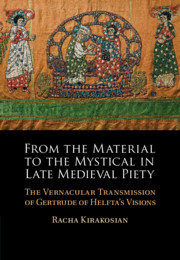 From the Material to the Mystical in Late Medieval Piety
From the Material to the Mystical in Late Medieval Piety Published online by Cambridge University Press: 01 September 2021
In this book I have suggested that the vernacular corpus of Gertrude’s visions challenges the long-standing idea that translations do not bear the same literary or historical weight as the supposed originals upon which they are based. Instead, the independent value and depth of redactions, especially those in other languages, has been highlighted, contributing to debates on vernacularity and manuscript culture. Hagiographic texts that have been redacted, especially when viewed in context of the reform movement, elicit a shadow history of late medieval piety wherein material culture infused mystical devotion. With redactors assimilating hagiographic traditions of rewriting saints’ dossiers,1 they offer us a better understanding of the social history of text production; we may speak of a social history here because we can observe the behaviour of scribes in a milieu united by common interests in matters concerning devotion. Practices of text production shaped reading practices in return, as many devotees became active redactors in the reception process. Studying the variety of manuscript transmission brings out the creative collaboration that medieval textuality entailed. It also shows how mystical devotion operated within a lifeworld in which material objects were charged with sacred power.
To save this book to your Kindle, first ensure [email protected] is added to your Approved Personal Document E-mail List under your Personal Document Settings on the Manage Your Content and Devices page of your Amazon account. Then enter the ‘name’ part of your Kindle email address below. Find out more about saving to your Kindle.
Note you can select to save to either the @free.kindle.com or @kindle.com variations. ‘@free.kindle.com’ emails are free but can only be saved to your device when it is connected to wi-fi. ‘@kindle.com’ emails can be delivered even when you are not connected to wi-fi, but note that service fees apply.
Find out more about the Kindle Personal Document Service.
To save content items to your account, please confirm that you agree to abide by our usage policies. If this is the first time you use this feature, you will be asked to authorise Cambridge Core to connect with your account. Find out more about saving content to Dropbox.
To save content items to your account, please confirm that you agree to abide by our usage policies. If this is the first time you use this feature, you will be asked to authorise Cambridge Core to connect with your account. Find out more about saving content to Google Drive.